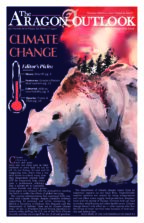
This editorial represents the opinion of 12 out of 14 Outlook editors.
The San Mateo Union High School District adopted a new compost system earlier this year, introducing compost bins around school campuses. As our generation faces the imminent danger of global warming, the Outlook praises the school district for implementing environmentally-conscious practices in sorting trash, paving the way towards a more sustainable future. While we recognize that it is the student body’s responsibility to correctly dispose of their waste, we believe that there are simple, specific actions the district could take to promote sustainability: current practices significantly limit the potential of the new composting program. The Outlook believes the existing bins should be grouped together, and the bins should be labeled more clearly to educate the student body and minimize confusion.
First, the inconsistent and misleading labeling causes confusion. Some green bins have a recycling symbol or have the word “RECYCLE” written on the labels and bins. While composting is technically a type of recycling, using these terms interchangeably further confuses that student body, who are, for the most part, unsure as to what is compostable or recyclable material. The district should prioritize clear and concise labeling on all bins to help educate students in and out of school.
According to Facilities Plant Manager Don Ahuna, if more than 10 percent of items placed in the compost bin are not compostable, the entirety of the bin is thrown in the trash, which is why clear labeling is crucial. Throwing away compostable material that contains a few pieces of trash defeats the purpose of having compost bins, and is not sustainable in any way.
Another reason why the new compost initiative is struggling to succeed at Aragon is because of the bins’ placement. While some of the bins are grouped together, most bins are sparse and separate around campus, especially in the hallways, the science wing and classrooms. Students who have something compostable are unlikely to walk across the entire campus to find a compost bin. Similarly, if they have something that is not compostable but there is no garbage bin in sight, they will likely contaminate the compost bin instead of searching for the appropriate bin. Placing all the bins together significantly increases student likelihood of taking the time to dispose their trash thoughtfully and correctly. As a long term plan, the Outlook urges the San Mateo Union High School District to invest in three-compartment trash bins, such as the ones typically seen in malls and airports.
We hope that these small changes will further educate Aragon and the greater San Mateo community on sustainability and encourage environmental consciousness.

